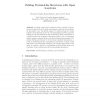Free Online Productivity Tools
i2Speak
i2Symbol
i2OCR
iTex2Img
iWeb2Print
iWeb2Shot
i2Type
iPdf2Split
iPdf2Merge
i2Bopomofo
i2Arabic
i2Style
i2Image
i2PDF
iLatex2Rtf
Sci2ools
ECAL
2007
Springer
2007
Springer
Folding Protein-Like Structures with Open L-Systems
Abstract. Proteins, under native conditions, fold to specific 3D structures according to their 1D amino acid sequence, which in turn is defined by the genetic code. The specific shape of a folded protein is a strong indicator of its function in the cell. The mechanisms involved in protein folding are not well understood and predicting the final conformation of a folded protein from its amino acid sequence alone is not yet achievable despite extensive research efforts, both theoretical and experimental. The protein folding process may be viewed as an emergent phenomenon, a result of underlying physics controlling the interaction of amino acids with their local environment, leading to the complex global fold. In this spirit we present a model for investigating protein folding using open L-systems, local rewriting rules with environmental interaction. Key words: Protein-folding, L-systems, open-L-systems
| Added | 07 Jun 2010 |
| Updated | 07 Jun 2010 |
| Type | Conference |
| Year | 2007 |
| Where | ECAL |
| Authors | Gemma B. Danks, Susan Stepney, Leo S. D. Caves |
Comments (0)

